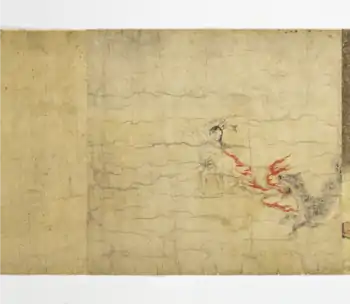Hell Scroll (Nara National Museum)
Hell Scroll (地獄草紙, jigokuzōji) is a scroll depicting seven out of the sixteen lesser hells presented in Kisekyō ("Sutra of the World Arising"). Six of the paintings are accompanied by text, which all begin with the phrase "There is yet another hell", following a description of what the sinners depicted did to end up in this particular hell. The seven hells depicted are the Hell of Excrement, Hell of Measures, Hell of the Iron Mortar, Hell of the Flaming Rooster, Hell of the Black Sand Cloud, Hell of Pus and Blood and Hell of Foxes and Wolves. It is considered likely that the scroll corresponds to the Paintings of the Six Paths, commissioned by Emperor Goshirakawa in the 12th century. This handscroll was preserved in Daishō-in in Higashiokubo, Tokyo until the Meiji period,[1] when it came into the hands of the Hara family of Kanagawa, later ending up in the possession of the Japanese government.
| Hell Scroll | |
|---|---|
 | |
| Artist | Unknown |
| Year | 12th century |
| Type | Color on paper |
| Dimensions | 26.5 cm × 453.9 cm (10.4 in × 178.7 in) |
| Location | Nara National Museum, Nara, Nara Prefecture, Japan |
The whole scroll
External links
| Wikimedia Commons has media related to Hell Scroll (Nara National Museum). |
References
- "Jigoku-zōshi". Encyclopedia of Japan. Tokyo: Shogakukan. 2012. Archived from the original on 25 August 2007. Retrieved 27 April 2012.
"Hell Scroll". Emuseum. National Institutes for Cultural Heritage. Retrieved 8 November 2010.

